
Hi Archinect!
We're in "full Piper" with a full house for the GSD's first public event of 2012, called "Museum as Genealogy"--and it's all Scott.
[Added note as of Jan 29]: For many of us as GSD architecture students, this kind of event is anticipated as a moment when some of the most important ideas that have guided our education are tested.
In this case, the ideas are those of Preston Scott Cohen, who teaches in the first (very formative) semester of the M.Arch.I core program. This is his practice and his project, to borrow a distinction that Peter Eisenman insisted on last year. For those of us heading into our M.Arch.I theses, this is Scott's thesis; it's an example of how a design can comprehensively address a complex range of requirements while remaining focused on certain set of questions. We see the work pinned up in the lobby; we hear its author present it in his own terms; and we witness as he vigorously defends and interrogates his own work under the questioning of an outside critic.
Some of the excitement around these events is specific to being a part of this particular institution: this is our education, after all. We have been shaped by the critiques these professors have given us on our own work. We also know many of the personalities involved, and anticipate the spectacle of seeing our familiar professors and mentors joust and jest with their peers--some known to us personally, some known only through their work and reputation, or not yet known not at all.
These conversations are part of a wider architectural discourse, and I hope that the content makes this clear. But my point is that these events (and my blogging of them) are the way that they are because they take on a personal significance for us at this school. In no way is this a neutral examination of some remote historical circumstance--whatever that might mean. It is the act of an institution, made of many different people and agendas, representing and assessing itself. Celebrating the achievements of its own people and being critically self-aware of its own agendas are two tasks that define the work of an institution, and this is what we are up to in this event. [end of added note]
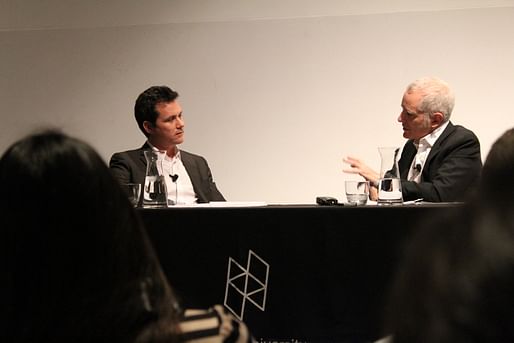
I've never seen Ouroussoff live and am very curious to see how this will go--there aren't that many people who can match wits with the chair of our department when he's on.
First, here are some images from the exhibition, whose opening this event marks:


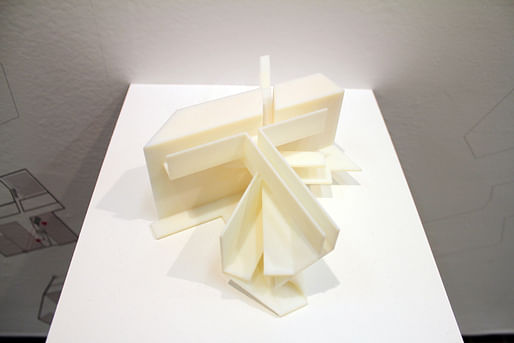

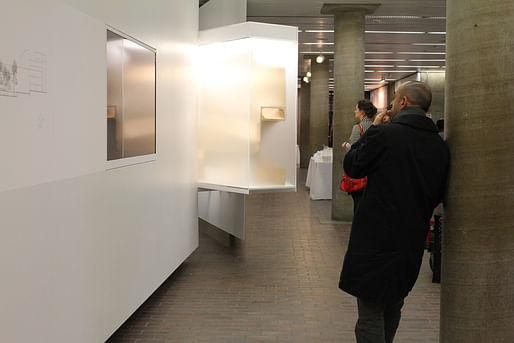
[Nader Tehrani contemplates a model of Lightfall, the building's central, tortuous atrium]
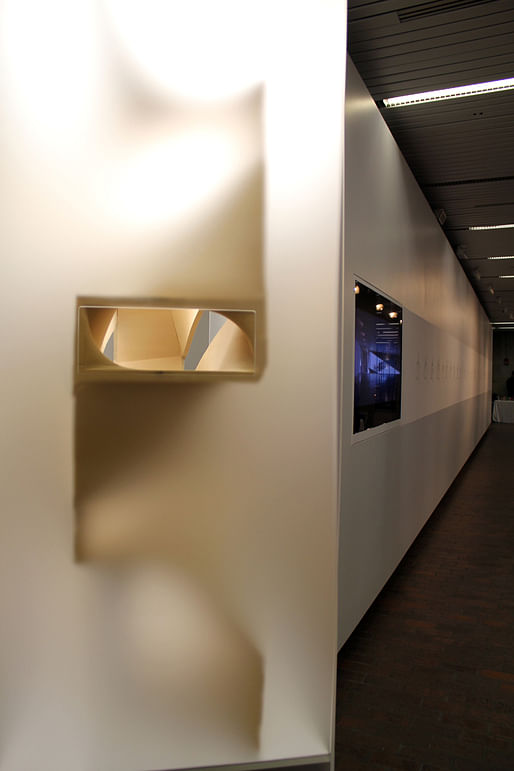
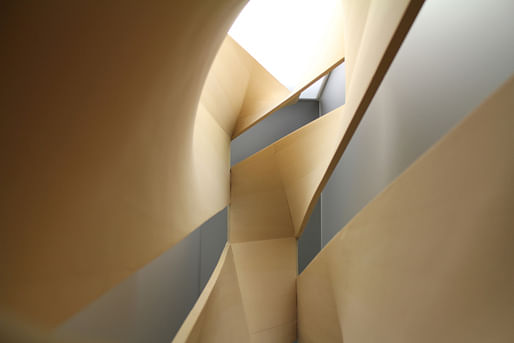
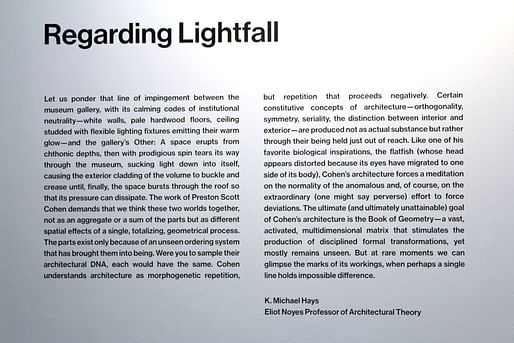
6:40pm: Mohsen is making introductions. PSC will speak for a few minutes, then NO, then they'll talk to each other, then the rest of us can ask questions.
"I must admit that I feel very unprepared for introducing Scott Cohen. Those of you who know Scott are fully aware that his introductions are beautifully written, very precise, quite long--and often more precise than the lectures. So I am unprepared."
"But it was pleasure, a few weeks ago, to be in Tel Aviv to see the museum...it was part of a trip with several people from Harvard [and he mentions the Dean of HBS (business), the Dean of HGSE (education), and several other deans]."
He's talking about how important it was to see the building in person and close-up, on the site. "It's very interesting how the building deals with compression, and other phenomena that Scott is interested in, such as distortion. ...and the compression happens in the context of the near-normalcy of the galleries, and also sets up a relational condition between the galleries."
"And I also feel a little nostalgic tonight. Seeing Scott's drawings (etc.) is a reminder of an earlier moment in the school when I witnessed Scott's development, and his friendship with Robin Evans. ...And we both miss Robin Evans very much, as he died so young." [Scott is nodding.]
"The third thing is pedagogy." Scott has been very precise in his relationship with pedagogy [yep]. "There's something incredibly didactic about this exhibition...and it's very rare to find this kind of tour de force of a relationship between pedagogy and practice."
"It's also an incredible opportunity as Nicolai is here. As you know, for many years Nicolai was the architecture critic for the NYT and has on many occasions been nominated for the Pulitzer."
Scott takes the podium and starts by thanking all involved, too many for me to transcribe here.
PSC: "...I'll start with the dialectic between the museum and architecture. If the museum tries to be anything other than neutral, it runs into difficulties. We can look to the founding of the museum and realize that neutral spaces, of one form of the other, become the only option." When art objects become torn from their original contexts, they move into a neutral context of the art museum, which is like every other neutral art museum in the world.
"There are a few exceptions: the Isabella Stewart Gardner Museum in Boston, and the Guggenheim in NYC."
PSC: "The site makes the building practically invisible."
"It may be useful to think back to eight years ago, when this project started. We were still feeling the shocks of two competing visions." One was the Guggenheim in Bilbao, and the other was the MoMA in New York, about which, as PSC notes, Ouroussoff wrote: "museums are as much about the stamp of legitimacy as about aesthetic pleasure.'"
"This opposition was on my mind," and made PSC think that the museum should be both: an inversion of the Guggenheim, "but not in the way that the MoMA is."
6:57pm: PSC is now analyzing the Guggenheim. "It is essentially an extremely tall picture gallery." And he sets it in a lineage with dioramas and cabinets of curiosities. "The cabinet of curiosity inhabited a curious scale: larger than an object, smaller than a room." Similarly, the Guggenheim, is caught in-between, larger than a room. It both invites people in for a private viewing, and puts these people on display, like on a shelf. "It is this model, the cornucopic microcosm, that corresponds to the cabinet of curiosities." It is, given its exterior form, also an object of curiosity within the city.

7:03pm: Comparison of the 19th century enfilade type museum with the Guggenheim, as an "enfilade in half."

7:04pm: "The Tel Aviv museum (TAMA) works like the cabinet, but differently. First, TAMA's interior can be seen as the two shells of a Renaissance domes: one coarse and the other smooth. The inner represents the infinity of the heavens and the outside represents itself to the city. In TAMA, Lightfall "formally enacts the contortion necessary to bring about a series of galleries on a constrained site." "Lightfall amplifies each to opposite extremes, exhibiting what was once called 'perverse functionalism.'"
"TAMA's facade behaves like the Guggenheim ramp, as if it were turned inside out. ..It's anamorphic form intensifies a series of movements to and past the building. A complicated reading complicates this, however. ...The Lightfall and the facade are two equivalent surfaces; and the walls of the surrounding buildings constitute a third set of surfaces."
"The contemporary museum does not try to bring in and organize the world, subjecting it to a teleological directory; it no longer follows its earlier didactic impulse but explores a wider range of subjectivities."
Another subject: "the way that interiors and exteriors are related to each other in large institutional buildings." "The systems for control and organization for such buildings" [conflicts with] the need for the building to actually function as more than one building, each independent of the other (and each program with its own entrance).
TAMA has two functions: it is both a museum and a library. Yet a library in a museum, without its own entrance, just becomes a room in the museum.
Now there is a great animated sequence of views of the model and drawings, talking about these tensions, as retroactively theorized--check these out in the video. [Scott acknowledges that this part of his argument was developed as a collaboration with Carl d'Apolito-Dworkin, my studio TA from last semester! Woot!]
"But...the library fails to...match the power of its nemesis, the Lightfall." The Lightfall eludes particular association with any one space.
"The contest would now seem to be between horizontality and verticality..."
7:17pm: PSC is comparing this kind of tension and hybridity with a similar condition in his Los Gatos house.
7:19pm: "TAMA is a multi-program building that cannot be isomorphic between its interior and exterior, but in which each program tries to dominate the exterior, making it isomorphic with itself."
"One of the most rewarding elements of this has been to witness that which could never [be predicted]," that is, how the curators have inhabited the building with various art installations. "...And I hope this may represent the beginning of another genealogy."
7:20pm: Applause. Ouroussoff and PSC sit down.
NO: "First, I'd like to say how refreshing it is to hear an architect talk about genealogy, which most architects don't want to acknowledge."
"When I think of the Guggenheim Bilbao in the mid and late 90s, we think about the fall of the Berlin Wall, [various political and economic circumstances], brand art, etc. For the first time, the architect put himself on an equal footing with the artist." "That was a huge shift for architects, because for a long time they felt that their voices had been suppressed."
MoMA is different. It was reacting to Bilbao as well as anxieties of modernism. "Trying to figure out a new narrative without letting go of the old one." "And yours comes out as a response to both buildings."
"The third historical, and hysterical, moment was the competition at Ground Zero."
NO: "The second issue" is the lack of a middle ground in thinking about what makes an appropriate space for viewing art. NO discloses that he's married to an artist.
"And the third thing to talk about is execution. Both in terms of issues such as entry...and in the most pragmatic way, gallery spaces--and how it is we look at art, and how gallery spaces reflect our understanding of that."
"So let's talk about what it was...you were trying to avoid, when you got the competition."
PSC: "I was probably trying to avoid...something about the will of the architect." Ambivalence. "It's a sublimation, in a way, that needs to be deployed through techniques."
There's a discipline in the building that marks it off from buildings [like Bilbao] that are born in gesture.
"I enjoy--and I think many at the GSD do--there's a culture here of enjoying how the constraints of architecture will bring us into new solutions. And to discover constraints as a source of invention. You've seen the site, but the most important constraint was the curator who tragically passed away months before the opening of the building. He was very protective of the way that lighting worked; we went to many galleries so he could show me what kind of light he didn't want. He didn't let me have natural light. He didn't like any of the museums in Boston, by the way, mostly because of lighting. He showed me how light hit objects...from three different directions, casting shadows..."
"We saw the new ICA which was under construction--I won't tell you what he said about it."
NO: "You restrained yourself to rectangular galleries, then distort them by ripping them open. ...Was the rectangular requirement from the curator?"
PSC: "He did say that, and he knew given the site that it was a problem. ...And the building ultimately betrays some of its principles, because of the way [it deals with its various constraints.] But those were not volunteered from the outset."
"I'd like to talk about material choices, and how political and cultural those choices are. It was mandated almost from the beginning that this building be stone, and thus be identified as a civic building, identified with Jerusalmen more than Tel Aviv. So the panelization was dedicated to the problem of making it stone." That eventually became impossible because they were hanging upside down, etc., so it had to become concrete in the end. "But it recalled either the bad brutalist architecture, or military interventions. ...But the form overcomes it; the potential to see it alive."
"...It looks almost metal, because of their size and how smooth they are. But this internationalizes the building; it's somewhat alien [to its site], in that sense, even though its so tightly knit into it."
"He did invite a foreign architect--and I never got to the bottom of that--because he was so dedicated to this being an Israeli project, but hired a foreign architect."
"One day he did explain his vision to me, which had to do with bringing a foreign [representation of Israel to itself]."
PSC: "There was a point in the process when he looked at the project and said 'What are all these cockamamie shapes?' And he was lost. But he trusted me. So this makes the difference between whether you're going to make a great building or not--whether you are trusted."
"At one point, people didn't like [that PSC and the curator had so much control over the design]," but now people are really excited, seeing how many ways there are for art to inhabit the building."
NO: "The entry sequence is very interesting: you lose control [when people enter and can decide to go various ways]. It's a problem at Bilbao, where you have to choose where to go, and then always return to the atrium."
PSC: "Yes, there are moments of multiple choice. It almost killed me in the competition when a juror said 'I'm lost and everyone's going to be lost.'"
"But there are multiple collections, different kinds of galleries for different things. The building is small enough, with a centralized focus, and the section [motivates you to move up and down through it]."
Questions from the audience.
Q: "All of this brings to mind a cinematic process. Is the building the last frame in the sequence of negotiation, or is an intermediate frame catching the negotiation as it is taking place?"
PSC: "I wouldn't say it's the last, but it might be all the frames, or the optimal compression of the whole stories. I don't think of it as a fragment of the process, as if we picked a place to stop." "And it could have gone forward. Lightfall is a mature space, in the way that it occupies the building; but there's another space in the library, that could have gone on [if it were not for other contingencies]." [Fancy way of saying that there were spaces that he'd liked to have developed more?]
Q: "Could you explain more what the aesthetic is based on? Some of the imagery reminded me of the beauty of a glacier, despite all its complex geometries--but the geometries of a glacier are natural."
PSC: "I might not be so refreshing when I say that I'm not willing to admit, or I don't know why, I want the building to look this way." [laughter] "I know what I want the building to do, in terms of epistemological subjects [etc.], but I can't quite say why I want it to look that way."
[end.] Scott thanks Nicolai Ouroussoff.
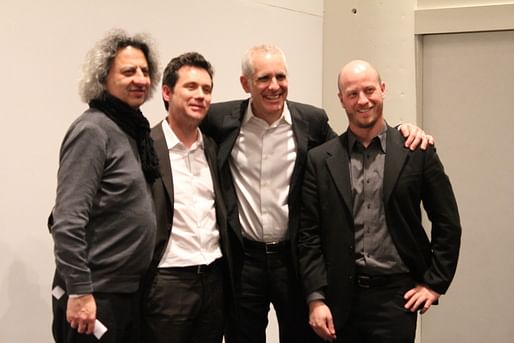
[After the softball game pitched by Ouroussoff: Mohsen Mostafavi, Nicolai Ouroussoff, Preston Scott Cohen, and Ben Prosky.]
This blog was most active from 2009-2013. Writing about my experiences and life at Harvard GSD started out as a way for me to process my experiences as an M.Arch.I student, and evolved into a record of the intellectual and cultural life of the Cambridge architecture (and to a lesser extent, design/technology) community, through live-blogs. These days, I work as a data storyteller (and blogger at Littldata.com) in San Francisco, and still post here once in a while.



16 Comments
This is embarrassing for the GSD. A night dedicated to Scott's ego.
yeesh, tough crowd. you'd think excess ego wouldn't seem so novel...
anywho, i appreciate the writeup!
excess ego is one thing and nothing new to architecture, but a full-on circle jerk on the work of a guy who is, at best, an annoyingly loud eisenman-light figure at this moment in time seems weird. GSD your architecture dept. is quickly becoming a joke.
Heard through the rumor mill that he was stepping down and would be replaced by a Spaniard, is this monument to ego of an exhibit and lecture perhaps the deal that was struck for him to go away quietly?
I do appreciate the write up tho, it is good to expose these bozos - not shooting the messenger here Lian, I'm a fan ;)
who's the Spaniard? I'm curious to hear. Seems to me Scott's simply come to the end of his "term," so to speak.
I'm curious also, though: what's your reference point for "no joke" architecture?
Wait, but Toshiko was chair from 2002 to 2008 - 6 years. Silvetti 1995-2002. Scott only served 4. mmm...
My sources say Abalos - but it is just rumors.
I dont understand your question: "what's your reference point for "no joke" architecture?"
Waldheim and Mehrotra are great, the GSD needs someone equally as great in architecture. I graduated a while ago but if I were applying today, architecture would be my third choice of program. That program seems stuck in 80's eisenmanian arguments. It is not only that the ideas are not in step with today's more populist zeitgeist, it is that these ideas and the program are stale.
Technology DOES NOT equal ideas. People can go learn rhino, grasshopper, and CAD CAM at tech schools.
Hm, I hadn't done the math. You seem to have a point. And Abalos = not bad, in my book.
Sorry about the "no joke" question - that was a little smarmy, as they say. I was just wondering what you consider the gold standard of architecture. There are clearly different camps... I personally think Scott has a worthwhile approach, though I agree its not in line with the zeitgeist. I was just wondering who you consider #1 within the zeitgeist (or top 3?). Even if they wouldn't agree to chair the GSD, if asked.
Do you really think the GSD is so tech-centric? I would say quite the opposite is the case; technology is often "faked" for rhetorical effect, for example.
Well an institution like the GSD should not jump on trends and that is not what I am arguing. It should have a leader that is flexible and able to bring the different architectural camps together while experimenting with new ideas. Scott Cohen just simply was not that guy, he is too focused on being the last cheerleader in the pep rally of architectural autonomy.
Abalos seems well rounded and like a good option.
Is this Scott Cohen guy some sort of tyrant or something? I would not know I did not go to the GSD
walheim? really? landscape urbanism is soooooooooo 2008. Anyways is it that bad that finally someone who studied and teaches in the ivory tower puts their money where their mouth is and actually builds something? Something that is actually pretty good?
Go on GSD and hire another average european architect who is by now old and sort of famous and hide behind them to try and make yourselves look good. I don't blame GSD for doing that, who else are they look to?
Oh yeah and don't forget to continue publishing your selves in various journals and avoid actually building anything.
sorry will.i.design you make architects sound like a prada purse. Maybe this Scott Cohen guys is no good as a chair or instructor for the GSD, but I have to say I am impressed that he completed that project, and I thinks its ok to celebrate that.
...sorry the above statement is full of spelling and grammar mistakes, read below for the correct version
Is this Scott Cohen guy some sort of tyrant or something? If he is I would not know, I did not study at the GSD
will.i.design: Waldheim? Really? landscape Urbanism is soooooooooo 2008. Anyways is it that bad that finally someone who studied and teaches in the ivory tower puts their money where their mouth is and actually builds something? Something that is actually pretty good?
Go on GSD and hire another average European architect who is by now old and sort of famous, and hide behind them to try and make yourselves look good. I don't blame the GSD, who else are they going to look to for a new chair?
Oh yeah and don't forget to continue publishing your selves in various journals and avoid actually building anything.
sorry will.i.design you make architects sound like a brand name purse or something. Maybe this Scott Cohen is not a good chair or instructor for the GSD, but I have to say I am impressed that he completed that project, and I think its fine to celebrate that.
@david - the idea that architecture's only concern is architecture (in its most abstract sense). no other concerns can nor should be considered .
@archinet - i kinda agree with you on waldheim, but you don't really have arguments and Im not even entirely sure you understand what is being discussed. architects complete buildings every day - like this one - they are nothing to celebrate in this manner. i would treat designers like hand-bags but that was soooo 2006 (nicely done, adding more o's did make me feel better and like i actually had a point).
I just saw this comment thread and wanted to post my thoughts about it (and since it's my blog, I took the liberty of adding this at the top of the post itself).
Of course, this event was both a critical engagement of the project and a celebration. I can see how it could seem out of place to non-GSD types, when this blog posts is compared with coverage of other events, such as public lectures by visiting architects who are less familiar to us.
But it is not unlike how our thesis reviews operate, for example: projects are presented, discussed, and yes, celebrated. Even while each project is critiqued on different grounds or with different levels of intensity, a party is thrown for all the students. And when Scott finishes his own thesis, we throw him a party. How could we not?
Lian I noted the caption on that first photo "After the softball game" is this a criticism of the lack of criticality during the event? If so it seems you wouldn't be the only person making that point...
Nam, given Ouroussoff's stature and how sharp he is in his critical writing, it looked to me like he was holding back. This is regardless of how much he likes or loves the project--one can always ask tough questions. That being said, people think differently in writing as compared with orally and on the spot!
I think it's tricky. To ask softball questions in a forum like this, one has to be prepared and articulate and very well informed. To ask tough questions without coming across as canned or self-serving, one has to both prepare meticulously and think deeply and frankly on the spot, in addition to being articulate and very well informed. That's a tall order--more than I could do--and I think it's easy to default to asking easier questions rather than misstep. I certainly have done this in much smaller forums.
AND I must say that I never catch every word or every section when I live blog, and it is often the densest and most difficult sections that I am not able to capture on the spot. So don't take my coverages as definitive of the entire event! For anyone who is interested, the video will show some pretty interesting analysis (and visuals) that are not represented here.
Lian, I went to the GSD. I am more than familiar with these people. Though, I graduated enough years ago that I was not as exposed to Scott as you and the classes coming out now.
This is def. different than most professor lectures/exhibits (which happened in a small wall not the entire gallery). Just know that things were not always about Scott and his buddies.
So, will.i...,
do you?
this aint about me. but yes. i do.
Look as a GSD alumn I have been just observing whats going on there from afar and I am concerned.
Architects, your program is diminished in the context of a profession in decline -- what are you gonna do about it? Or we can celebrate the chairman's 'thesis' in the most self-serving way possible and hope SOM will hire us.
Block this user
Are you sure you want to block this user and hide all related comments throughout the site?
Archinect
This is your first comment on Archinect. Your comment will be visible once approved.